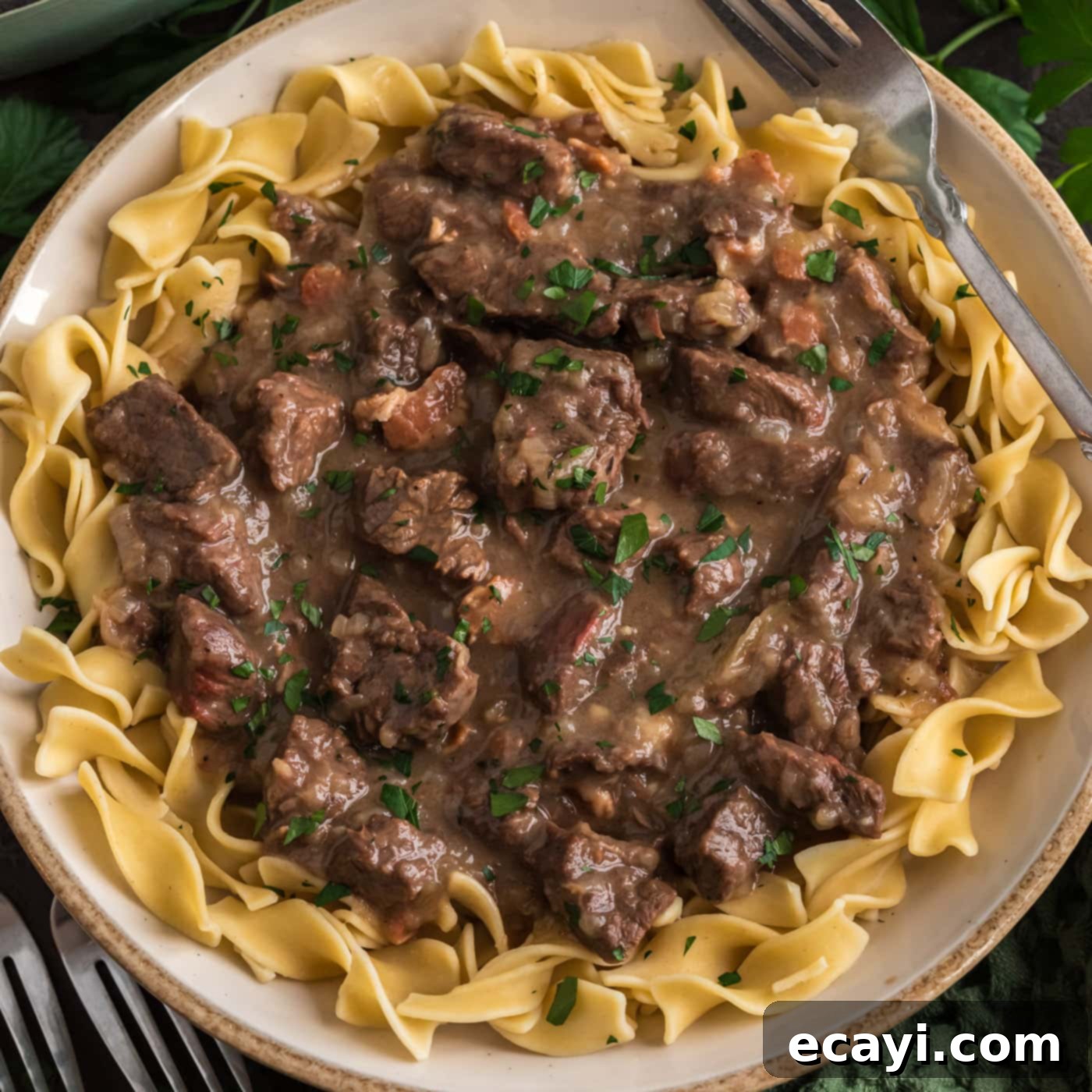Authentic Belgian Beef Carbonnade: A Hearty Beer-Braised Beef Stew Recipe
Prepare for a culinary journey with this incredibly flavorful Beef Carbonnade, a traditional Belgian beef stew that will quickly become a cherished favorite. Infused with the savory depth of beef, the smoky richness of bacon, and the distinctive character of a good beer, this recipe takes comfort food to an exquisite new level. A generous addition of onions, slowly simmered until they practically melt into a luscious gravy, completes this irresistible dish, promising a deeply satisfying meal that’s perfect for any occasion, especially on a chilly evening.
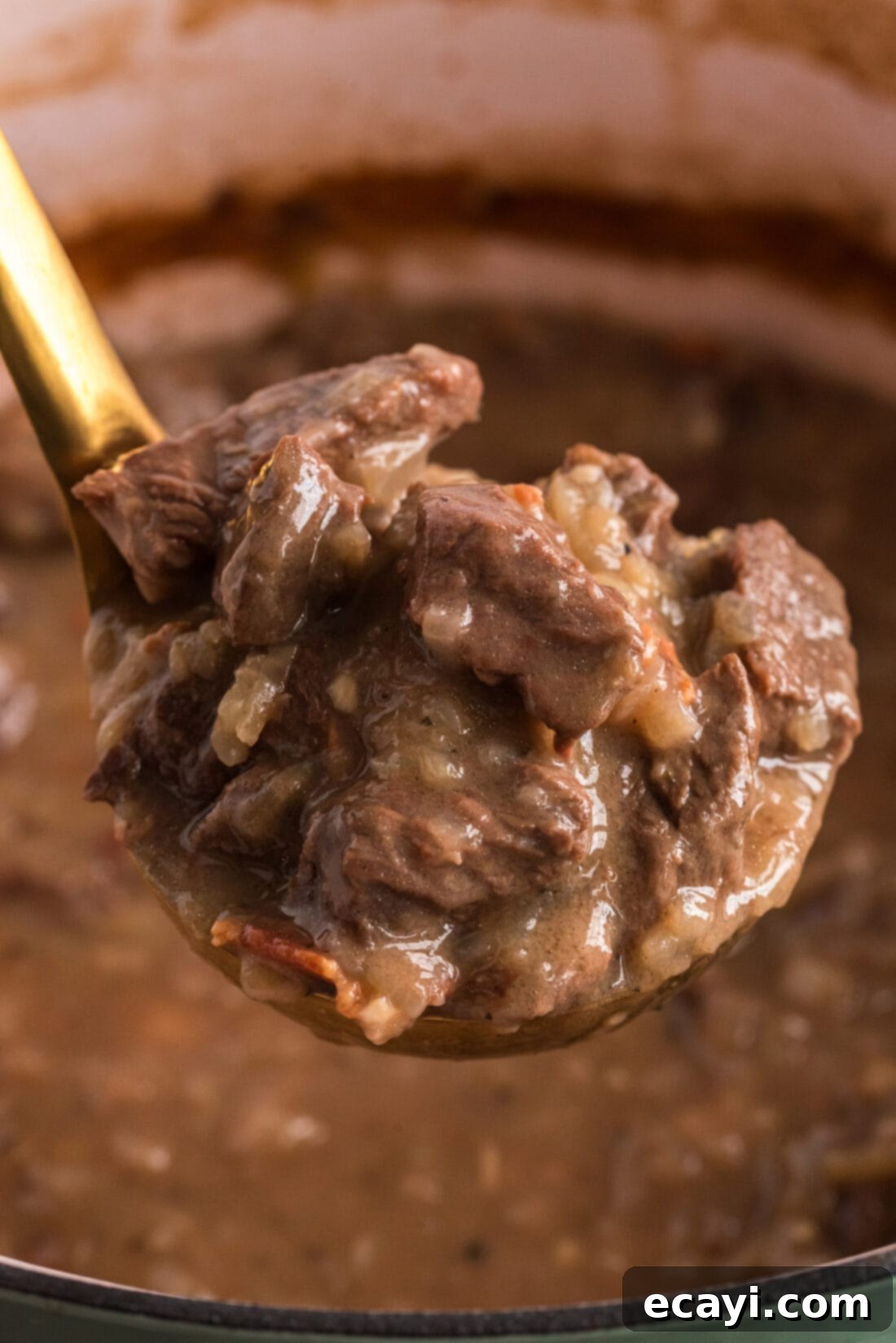
Why This Beef Carbonnade Recipe is a Must-Try
Beef Carbonnade, known in French as “Carbonnade Flamande,” is a classic Belgian stew celebrated for its robust flavors and tender meat. It’s essentially a hearty beef stew distinguished by its key ingredients: a generous amount of slowly cooked onions and the unique depth imparted by beer. This recipe truly shines because it embraces these traditional elements, transforming simple ingredients into a complex and comforting dish.
Many might be surprised by the sheer quantity of onions this recipe calls for, but trust the process! After several hours of slow braising in the oven, these onions undergo a remarkable transformation. They caramelize, sweeten, and gradually break down, almost disintegrating into the rich, velvety gravy. Their strong initial flavor mellows considerably, transferring a sweet, umami-rich essence to both the tender beef and the luxurious sauce. This slow cooking method allows all the ingredients – from the rendered bacon fat and browned beef to the aromatic garlic and herbs – to meld together seamlessly, creating a depth of flavor that is truly unparalleled in a beef stew.
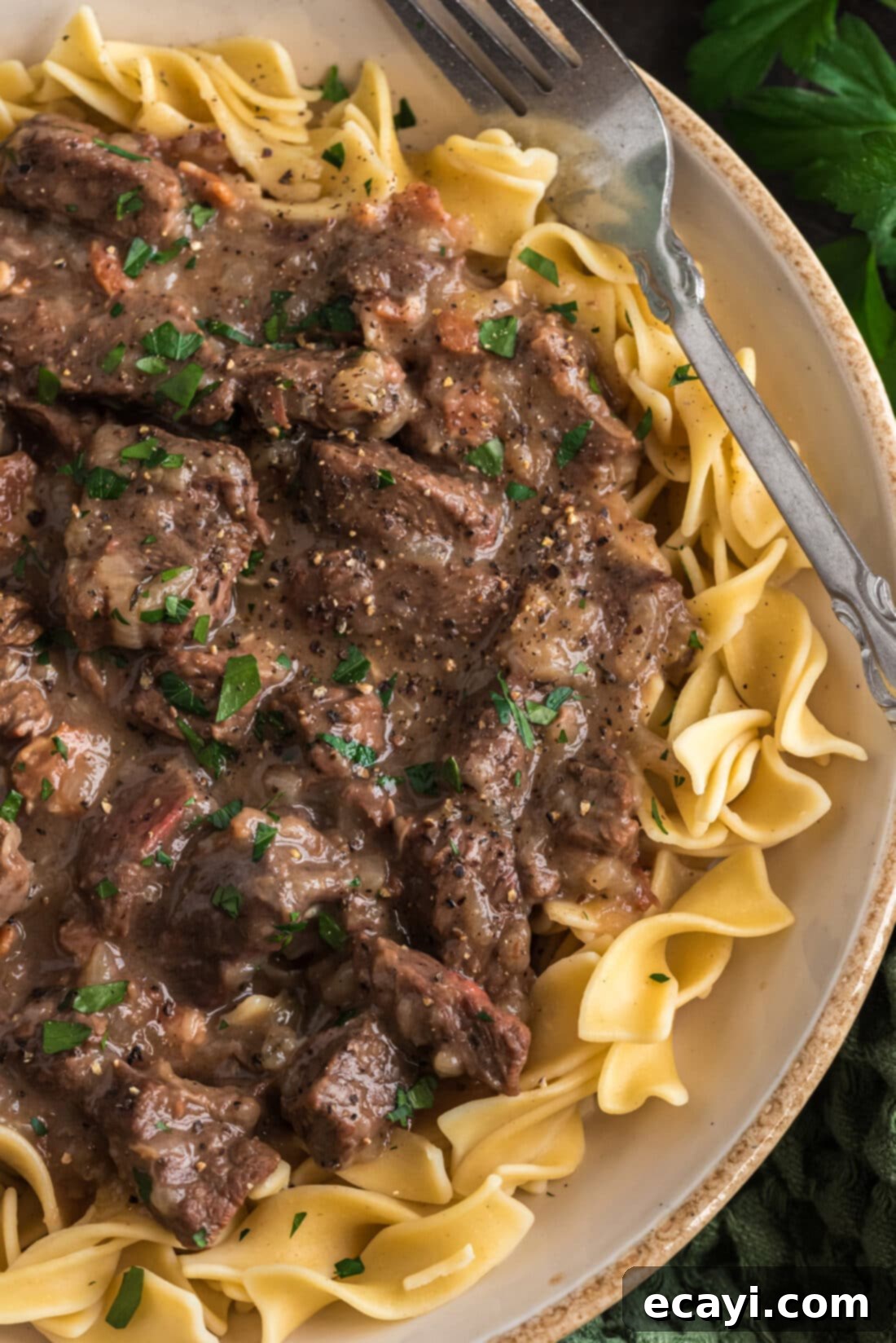
Key Ingredients for Your Flavorful Beef Carbonnade
Crafting the perfect Beef Carbonnade begins with selecting quality ingredients. While the full list with precise measurements is available in the printable recipe card at the bottom of this post, here’s a closer look at the stars of this Belgian-inspired dish and why they are essential for creating such a rich and satisfying stew.
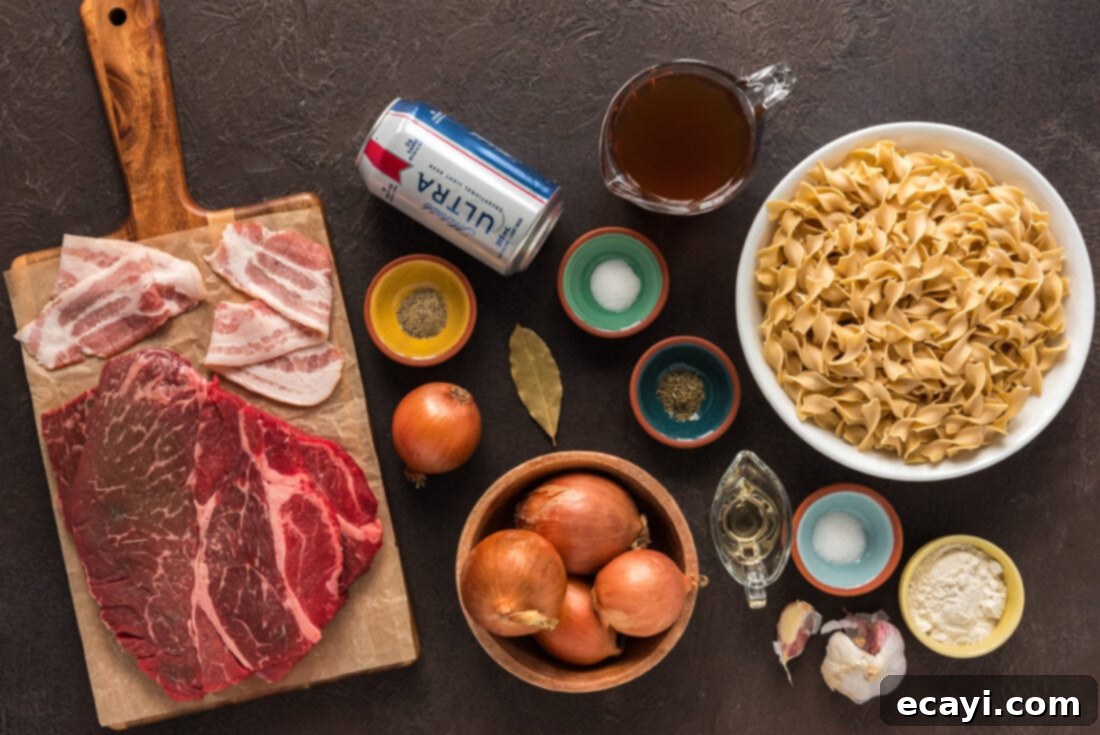
Ingredient Spotlight & Expert Substitutions
BEEF – For this robust stew, we highly recommend using two pounds of boneless chuck roast, cut into roughly 1-inch cubes. Chuck roast is an ideal cut for slow-cooked stews because its marbling and connective tissues break down beautifully over time, yielding incredibly tender, fall-apart meat that soaks up all the rich flavors of the braising liquid. While other cuts like stew meat or short ribs can work, chuck roast consistently delivers the best texture and flavor for Carbonnade. Don’t skip the crucial step of browning the beef, as this creates a deep, caramelized crust that adds tremendous flavor to the stew.
BEER – The choice of beer is central to authentic Carbonnade. Belgian ale is traditionally the most popular and recommended choice due to its complex flavor profile, often featuring notes of fruit, spice, and yeast that perfectly complement the savory beef and sweet onions. However, don’t hesitate to use a light or dark beer if Belgian ale isn’t readily available. A good amber ale or even a stout can also provide excellent results, contributing different layers of richness. If you’re concerned about the flavor of beer or its alcohol content, rest assured that the alcohol cooks out almost entirely during the long simmering process. What remains is a profound depth of flavor and richness that simply cannot be achieved with just broth or stock. It’s truly worth every last drop for that authentic taste.
ONIONS – As the name “Carbonnade” (derived from the French word “carbonnade,” referring to meat cooked over coals, but now strongly associated with this onion-rich stew) implies, onions are a foundational ingredient. We are not shy about the quantity, calling for a generous five cups of thinly sliced onions. This abundance is key to the stew’s signature sweetness and body. As they slowly cook, the onions caramelize, releasing their natural sugars and thickening the sauce, eventually almost melting away into the luxuriant gravy, leaving behind a subtle sweetness rather than a distinct onion taste. Yellow onions or sweet onions work best here.
GARLIC – A single clove of minced garlic adds an aromatic foundation, enhancing the overall savory profile without overpowering the main ingredients. Feel free to add a bit more if you’re a garlic lover.
FLOUR – All-purpose flour is used to create a light roux, which helps to thicken the stew to a perfect consistency, ensuring a rich, clingy gravy that coats the meat beautifully. This also helps to build body and prevent the stew from being too watery.
SEASONINGS – Simple seasonings like salt and pepper are essential for enhancing the natural flavors of the beef. Dried thyme and a bay leaf contribute classic herbaceous notes, adding warmth and complexity to the stew. The white wine vinegar and granulated sugar play crucial balancing roles, cutting through the richness and enhancing the caramelization of the onions and beer, respectively, to create a well-rounded flavor profile.
How to Master Beef Carbonnade: Step-by-Step
These step-by-step photos and detailed instructions are provided to help you visualize each stage of making this delicious recipe. For a convenient printable version, complete with all measurements and instructions, you can Jump to Recipe at the very end of this post. The process is straightforward, but patience during the slow braising is key to achieving incredibly tender beef and a deeply flavorful sauce.
- Preheat your oven to 325°F (160°C). This low and slow temperature is crucial for tenderizing the beef and allowing flavors to develop gradually.
- Begin by cooking the diced bacon in a large, heavy-bottomed Dutch oven over medium heat until it is wonderfully crisp. This step not only cooks the bacon to perfection but also renders out its flavorful fat, which will form the foundation of our stew. Once crisp, remove the bacon with a slotted spoon and set it aside, making sure to reserve all those precious drippings in the pan.
- Next, season your 1-inch beef cubes generously with salt and pepper. Add the seasoned beef to the reserved bacon drippings in the Dutch oven and cook over medium-high heat for about 3 minutes. The goal here is to achieve a beautiful, even brown crust on all sides of the beef. This browning, known as the Maillard reaction, is vital for developing rich, savory flavors that will permeate the entire stew. Make sure not to overcrowd the pan; you may need to do this in batches.
- After browning the beef, add the minced garlic to the pan and cook for just 30 seconds until fragrant. Then, remove the browned beef with a slotted spoon and set it aside with the bacon. Add the thinly sliced onions to the same pan. Cover the Dutch oven and cook the onions for about 10 minutes, stirring occasionally. This initial covered cooking helps the onions soften and release their moisture, kickstarting the caramelization process.
- Once the onions are softened, stir in the all-purpose flour. Cook for 2 minutes, stirring constantly. This step creates a roux with the rendered fat and onion juices, which will act as a natural thickener for our stew, giving it a luxurious, rich consistency.
- Pour in the beef broth, white wine vinegar, granulated sugar, dried thyme, and the bay leaf. Finally, add the beer. Bring the mixture to a gentle boil, stirring to ensure everything is well combined and the flour is fully incorporated without lumps. The vinegar adds a slight tang to balance the richness, while the sugar enhances the sweetness of the caramelized onions.
- Return both the cooked bacon and the browned beef to the Dutch oven, nestling them into the simmering liquid.
- Cover the Dutch oven tightly and transfer it to your preheated oven. Bake at 325°F (160°C) for a minimum of 2 hours, or until the beef is incredibly tender and easily pulls apart with a fork. The extended cooking time at a low temperature is what transforms the chuck roast into a melt-in-your-mouth experience. Before serving, remember to carefully discard the bay leaf. Serve this exquisite Beef Carbonnade piping hot over a bed of egg noodles or creamy mashed potatoes to soak up every drop of that glorious gravy.
Frequently Asked Questions & Expert Tips for Beef Carbonnade
Storing your leftover Beef Carbonnade is simple! Transfer any remaining stew to an airtight container and refrigerate it for up to 4 days. The flavors often deepen and improve overnight, making it even more delicious the next day.
Absolutely! Beef Carbonnade is one of those dishes that benefits immensely from being made in advance. We believe it tastes even better the next day as the flavors have more time to meld and develop. To reheat, simply warm the stew gently over medium-low heat on the stovetop, stirring occasionally until heated through. You might want to add a splash of broth or water if it has thickened too much.
Yes, Beef Carbonnade freezes wonderfully! Once the stew has cooked and cooled completely, transfer it to a freezer-safe airtight container or a large, heavy-duty freezer bag. You can freeze it for up to 3 months. When you’re ready to enjoy it, thaw the stew overnight in the refrigerator, then reheat it on the stovetop over medium-low heat until it’s thoroughly warmed. Freezing and reheating will not compromise its delicious flavor or tender texture.
A heavy-bottomed Dutch oven is highly recommended for making Beef Carbonnade. Its excellent heat retention and distribution are perfect for browning the meat evenly and for the slow, steady braising required in the oven. Cast iron Dutch ovens, especially enameled ones, are ideal as they can go directly from stovetop to oven and are easy to clean.
While traditional Beef Carbonnade focuses on beef and onions, you can certainly add other root vegetables for extra flavor and substance. Carrots, celery, or mushrooms are common additions. If adding carrots or celery, sauté them with the onions. For mushrooms, you can add them during the last 30-45 minutes of baking, or sauté them separately and stir them in at the end.
If your gravy is too thin, you can simmer the stew on the stovetop with the lid off for a bit longer to allow some liquid to evaporate and thicken. If it’s too thick, simply stir in a splash of beef broth or water until you reach your desired consistency. Always taste and adjust seasonings after any adjustments.
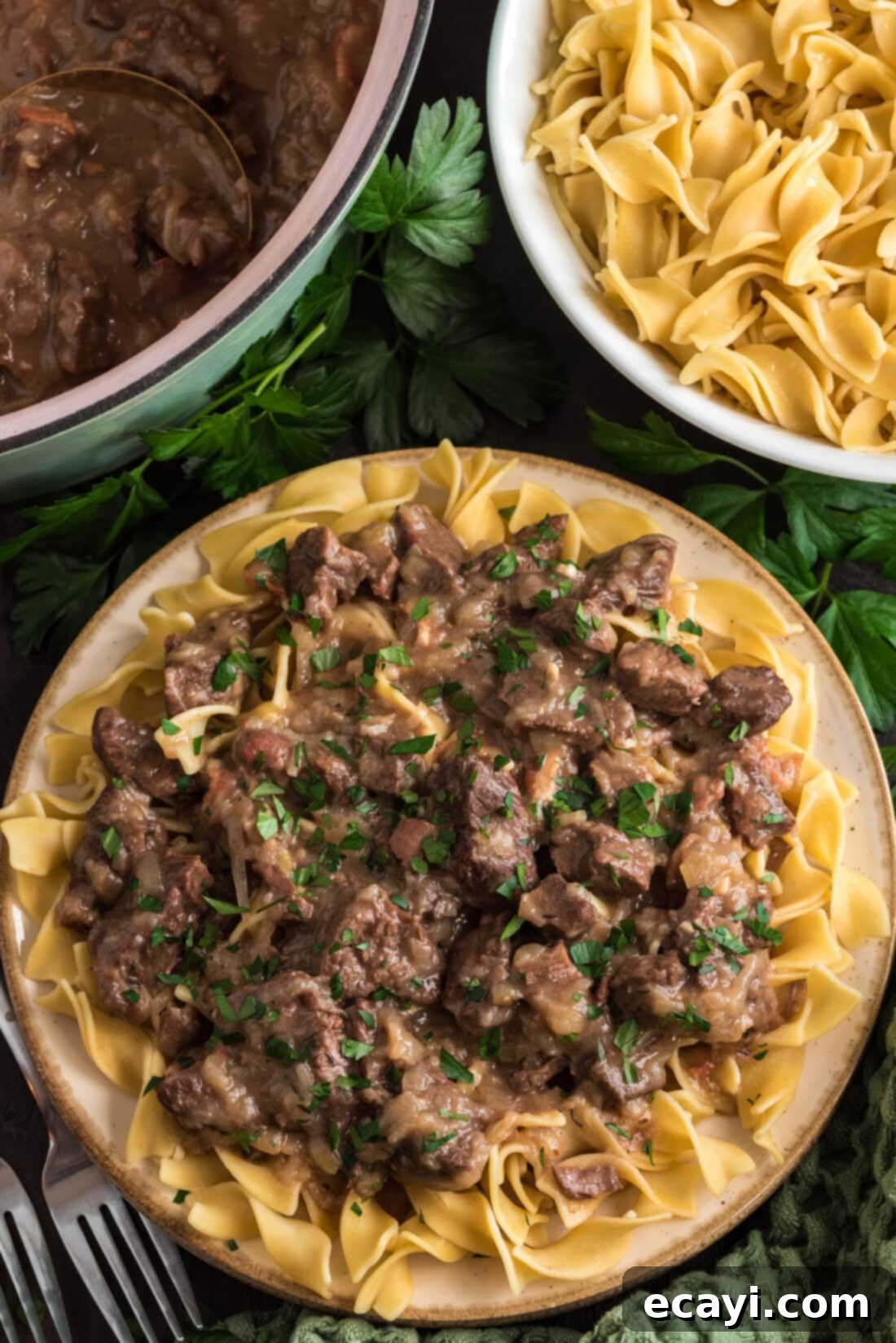
Delicious Serving Suggestions for Beef Carbonnade
This rich and hearty Beef Carbonnade is a meal in itself, but it truly shines when served alongside complementary side dishes that can soak up its magnificent gravy. Traditionally, it’s served over a comforting bed of fluffy egg noodles or creamy mashed potatoes, which are perfect for capturing every last drop of the flavorful sauce. Don’t be shy with your scoops of the rich pan gravy on top!
For an authentic Belgian experience, consider serving it with a side of frites (French fries), often accompanied by a dollop of mayonnaise. A fresh, crisp green salad with a light vinaigrette can provide a welcome contrast to the stew’s richness. Crusty bread or baguette is also an absolute must, ideal for mopping up any remaining gravy. Pair this robust dish with a glass of the same Belgian ale used in cooking, or a full-bodied red wine like a Cabernet Sauvignon or Merlot, to further enhance the dining experience.
Explore More Hearty Stew Recipes
- Classic Irish Stew
- Comforting Hamburger Stew
- Hearty Homemade Goulash
- Flavorful Beef Stew with Parsley, Sage, Rosemary, and Thyme
I absolutely love creating and sharing my kitchen experiences with all of you! To make sure you never miss a new recipe, I offer a convenient newsletter delivered right to your inbox. Simply subscribe and start receiving your free daily recipes, tips, and culinary inspiration!
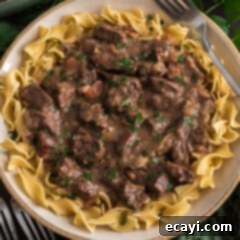
Beef Carbonnade
IMPORTANT – There are often Frequently Asked Questions and Expert Tips within the blog post that you may find helpful. Simply scroll back up to read them for additional insights!
Print It
Pin It
Rate It
Save ItSaved!
Ingredients
- 2 slices bacon finely diced
- 2 pounds boneless chuck roast cut into 1 inch cubes
- ½ teaspoon salt
- ½ teaspoon pepper
- 1 clove garlic minced
- 5 cups thinly sliced onion
- 3 Tablespoons all purpose flour
- 1 cup beef broth
- 2 teaspoons white wine vinegar
- ½ teaspoon granulated sugar
- ½ teaspoon dried thyme
- 1 bay leaf
- 12 ounces beer 1 can. Light or dark
- 6 cups cooked egg noodles
Things You’ll Need
-
Dutch oven
-
Slotted spoon
Before You Begin: Important Tips
- Choosing Your Beer: Belgian ale is the most authentic and popular choice for Carbonnade due to its rich and complex flavor profile. However, a good quality regular light or dark beer will also yield excellent results. Don’t fret about the beer flavor dominating the dish; the alcohol cooks out entirely during the long braising process, leaving behind a wonderful depth and unique richness that simply can’t be replicated with just broth or stock. It truly makes a significant difference.
- The Magic of Onions: The quantity of onions in this recipe might seem substantial, but it’s essential! During the slow, hours-long cooking in the oven, these onions will caramelize beautifully, release their sugars, and almost completely dissolve into the stew’s gravy. This process transfers incredible flavor and natural sweetness to the meat and sauce, creating a silky texture and a harmonious taste rather than a strong onion presence.
- Browning the Beef: This initial step is critical for developing deep, savory flavors through the Maillard reaction. Ensure your pan is hot and don’t overcrowd the beef, as this can steam the meat instead of browning it. Brown in batches if necessary.
Instructions for a Perfect Beef Carbonnade
-
Preheat your oven to 325°F (160°C). This ensures a low, slow heat for optimal tenderness.
-
In a large Dutch oven, cook the finely diced bacon over medium heat until it becomes perfectly crisp. Carefully remove the cooked bacon with a slotted spoon, reserving all the rendered drippings in the pan. Set the crisp bacon aside.
-
Season the cubed beef generously with ½ teaspoon of salt and ½ teaspoon of pepper. Add the seasoned beef to the bacon drippings in the Dutch oven and cook over medium-high heat for approximately 3 minutes, turning occasionally to brown the beef well on all sides. This crucial step locks in flavor.
-
Stir in the minced garlic and cook for just 30 seconds until aromatic. Then, remove the browned beef with a slotted spoon and set it aside with the bacon. Add the 5 cups of thinly sliced onion to the pan, cover, and cook for 10 minutes, stirring occasionally until softened.
-
Sprinkle the 3 tablespoons of all-purpose flour over the softened onions. Stir constantly and cook for 2 minutes to create a roux, which will thicken the stew.
-
Pour in the 1 cup of beef broth, 2 teaspoons of white wine vinegar, ½ teaspoon of granulated sugar, ½ teaspoon of dried thyme, the bay leaf, and the 12 ounces of beer. Bring the mixture to a full boil, stirring well to combine all the liquids and spices.
-
Return the reserved bacon and browned beef to the Dutch oven, ensuring they are submerged in the simmering liquid.
-
Cover the Dutch oven tightly with its lid and bake in the preheated oven at 325°F (160°C) for 2 hours, or until the beef is incredibly tender and yields easily to a fork. Once cooked, remove the bay leaf before serving. Ladle the rich Beef Carbonnade generously over warm cooked egg noodles for a satisfying meal.
Expert Tips & FAQs (Condensed)
- Leftovers: Store any remaining stew in an airtight container in the refrigerator for up to 4 days. The flavors often deepen and improve overnight.
- Make Ahead: This stew is excellent for meal prep! Prepare it a day in advance, store it in the refrigerator, and gently reheat over medium-low heat on the stovetop. It tastes even better the next day.
- Freezing: To freeze, transfer the cooked and completely cooled stew to an airtight, freezer-safe container or a large ziptop bag. Freeze for up to 3 months. Thaw overnight in the refrigerator and reheat on the stovetop until warmed through.
- Serving Suggestion: While traditionally served over egg noodles or mashed potatoes, a side of crusty bread is perfect for soaking up all the rich gravy.
Nutrition Information
The recipes on this blog are tested with a conventional gas oven and gas stovetop. It’s important to note that some ovens, especially as they age, can cook and bake inconsistently. Using an inexpensive oven thermometer can assure you that your oven is truly heating to the proper temperature. If you use a toaster oven or countertop oven, please keep in mind that they may not distribute heat the same as a conventional full sized oven and you may need to adjust your cooking/baking times. In the case of recipes made with a pressure cooker, air fryer, slow cooker, or other appliance, a link to the appliances we use is listed within each respective recipe. For baking recipes where measurements are given by weight, please note that results may not be the same if cups are used instead, and we can’t guarantee success with that method.
This post originally appeared here on December 14th, 2010 and has since been updated with new photos and expert tips.
